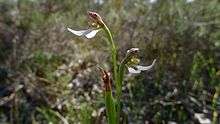Eriochilus dilatatus
Eriochilus dilatatus, commonly known as the white bunny orchid,[2] is a plant in the orchid family Orchidaceae and is endemic to Western Australia. It is a common and widespread, slender ground orchid with a single leaf and up to fifteen small white and greenish flowers with reddish or brownish markings and a hairy labellum.
| White bunny orchid | |
|---|---|
 | |
| Eriochilus dilatatus undulatus growing in Swan View | |
| Scientific classification | |
| Kingdom: | Plantae |
| Clade: | Tracheophytes |
| Clade: | Angiosperms |
| Clade: | Monocots |
| Order: | Asparagales |
| Family: | Orchidaceae |
| Subfamily: | Orchidoideae |
| Tribe: | Diurideae |
| Genus: | Eriochilus |
| Species: | E. dilatatus |
| Binomial name | |
| Eriochilus dilatatus | |
Description
Eriochilus dilatatus is a terrestrial, perennial, deciduous, herb with an underground tuber. Plants in flower have a single, egg-shaped leaf 15–75 mm (0.6–3 in) long and 5–15 mm (0.2–0.6 in) wide and attached about half way up the flowering stem. Plants not in flower usually have a larger leaf on a stalk 60–150 mm (2–6 in) tall. Up to fifteen, usually more than three white and greenish flowers 12–18 mm (0.5–0.7 in) long and 10–12 mm (0.4–0.5 in) wide are borne on a flowering stem 100–350 mm (4–10 in) tall. The dorsal sepal is spatula-shaped, 5–10 mm (0.2–0.4 in) long and 2–4 mm (0.08–0.2 in) wide. The lateral sepals are white or cream-coloured, 7–20 mm (0.3–0.8 in) long and 2.5–4 mm (0.1–0.2 in) wide. The petals are greenish with brownish-red stripes, 5–8 mm (0.2–0.3 in) long, about 1 mm (0.04 in) wide and more or less erect. The labellum is greenish cream, 6–11 mm (0.2–0.4 in) long and 3–5 mm (0.1–0.2 in) wide with clusters of cream-coloured to pale purple hairs, and is prominently curved downwards. Flowering occurs between March and June with some subspecies flowering more prolifically after fire.[2][3][4][5]
Taxonomy, naming and distribution
Eriochilus dilatatus was first formally described in 1840 by John Lindley and the description was published in A Sketch of the Vegetation of the Swan River Colony.[1] The specific epithet (dilatatus) is a Latin word meaning "spread out", "enlarge", or "extend",[6] referring to the broad labellum and lateral sepals.[4]
There are six subspecies:
- E. dilatatus subsp. dilatatus which grows in shrubland and woodland in near-coastal areas between Dirk Hartog Island and Israelite Bay;
- E. dilatatus subsp. brevifolius which grows in shrubland between Cataby and the Murchison River;
- E. dilatatus subsp. magnus which grows in high rainfall areas between Perth and Albany;
- E. dilatatus subsp. multiflorus found in woodland and forest between Jurien Bay and Albany;
- E. dilatatus subsp. orientalis which is only found near Caiguna;
- E. dilatatus subsp. undulatus which is the most widespread subspecies and grows in a range of habitats between Mullewa and Esperance.
Ecology
All bunny orchids are pollinated by small native bees, attracted to nectar at the base of the labellum.[2]
Use in horticulture
Eriochilus species are generally easily grown in pots in a bushhouse or cool glasshouse. They need to be watered regularly when growing but kept dry when dormant during summer.[2]:275,301
References
- "Eriochilus dilatatus". APNI. Retrieved 15 July 2018.
- Jones, David L. (2006). A complete guide to native orchids of Australia including the island territories. Frenchs Forest, N.S.W.: New Holland. p. 275. ISBN 1877069124.
- Hopper, Stephen; Brown, Andrew Phillip (2006). "New and reinstated taxa in Eriochilus" (PDF). Nuytsia. 16 (1): 33–36. Retrieved 15 July 2018.
- Brown, Andrew; Dundas, Pat; Dixon, Kingsley; Hopper, Stephen (2008). Orchids of Western Australia. Crawley, Western Australia: University of Western Australia Press. pp. 254–256. ISBN 9780980296457.
- Hoffman, Noel; Brown, Andrew (2011). Orchids of South-West Australia (3rd ed.). Gooseberry Hill: Noel Hoffman. pp. 220–221. ISBN 9780646562322.
- Brown, Roland Wilbur (1956). The Composition of Scientific Words. Washington, D.C.: Smithsonian Institution Press. p. 743.